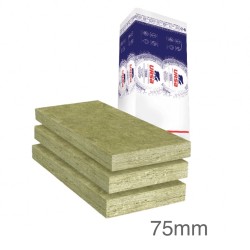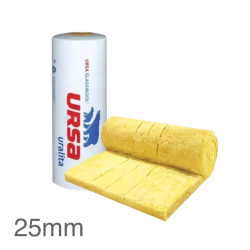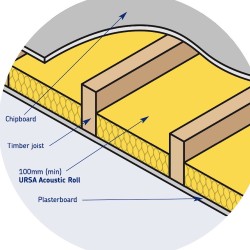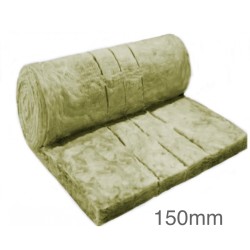125mm URSA 32 Cavity Insulation Batts (pack of 4)
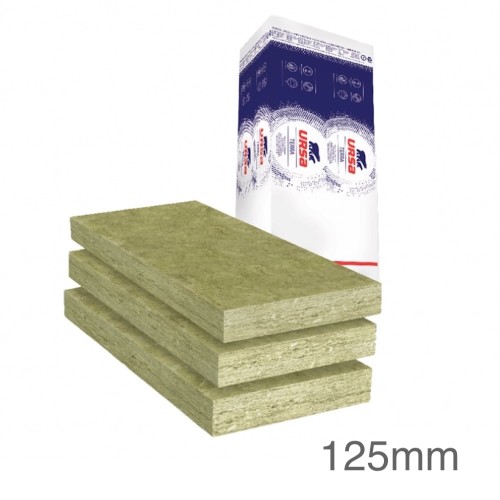
Guide Price
125mm URSA 32 Cavity Insulation Batts (pack of 4)
Guide Price: £36.73 (£44.08 inc VAT)
Price per m2: £14.93/m2 (£17.92 inc VAT)
- Product Code: A1-5154
- Delivery Time: 1 - 2 days
- Brand: URSA
- Model and Size: 1350mm x 455mm - 2.46m2
- Weight: 9.84kg
Our ratings on 23-04-2025:

4.7 out of 5 - Excellent


4.8 out of 5
125mm URSA 32 Cavity Insulation Batts (pack of 4)
Length: 1350mm
Width: 455mm
Thickness: 125mm
Pack Quantity: 4
Board Coverage: 0.61m2
Pack Coverage: 2.46m2
Density: 32kg/m3
Weight/m2: 4kg
Weight: 9.84kg
Thermal Conductivity: 0.032W/mK
R-Value: 3.9m2K/W
Fire Rating (Reaction to Fire): A1(Non-combustible)
Fire rating: Euroclass A1
125mm URSA Cavity Batt is a lightweight, semi rigid glass mineral wool slab treated with silicon-based water repellent. It is suitable for use in both fully and partially filled masonry cavity walls up to 25m high. It is manufactured from an abundant, sustainable resource and may utilize up to 80% glass waste.
CHARACTERISTICS
- Excellent sound insulation characteristics and enhance the acoustic comfort of the building.
- Reduces the risk of condensation and provides warmer conditions.
- May be used below the damp-proof course to offer a degree of edge insulation to the floor.
- Maintenance-free and has an indefinite life at least equal to that of the building.
- Has minimal resistance to the passage of water vapor, thus allowing the wall to breathe.
- Outstanding product quality manufactured to ISO 9001 Quality Systems.
- User-friendly - has a soft touch feel making it easier to handle and install while still maintaining its excellent mechanical properties.
- Environment-friendly - Glass wool is manufactured from an abundant, sustainable resource and may utilize up to 80% glass waste.
- Zero Global Warming Potential (GWP).
- Insulation savings.
- Adaptable - One product may be used for both full and partial fill systems.
APPLICATION
- Full fill cavity systems - In any exposure zone in buildings up to 25m high.
- Partial fill cavity systems - The risk of wind-driven rain penetration increases in exposed or coastal locations. The use of a residual 50mm clear cavity means URSA Cavity Batts may be used in any exposure zone. British Board of Agrément approval means that in many instances only a 25mm residual cavity needs to be maintained.
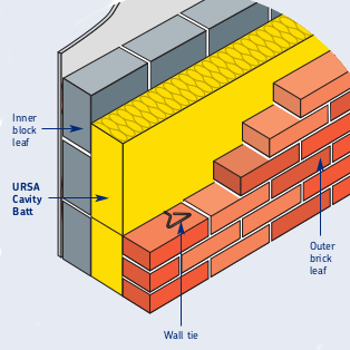
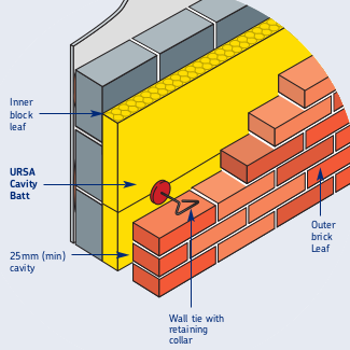
Full fill
Partial Fill
INSTALLATION
Full Fill Systems
The wall may be constructed leading with either leaf. It is good practice, however, to construct the outer leaf first as this allows the mortar joints on the cavity face to be cleaned and to check that the mortar joints are all fully filled. The URSA Cavity Batts are then installed as the wall is built.
- The leading leaf of masonry, normally the outer leaf, is built with the first row of wall ties at 600mm centers where the insulation is to begin.
- The first row of URSA Cavity Batts, cut to size if necessary, may begin below the DPC to offer edge insulation to the floor.
- The inner leaf is then built, normally level with the top of the URSA Cavity Batts. It is permissible to build the outer leaf one brick higher to secure the next row of slabs and ensure mortar is cleaned from the cavity face.
- Raise the leading leaf to the level of the next row of wall ties, normally at 450mm vertical centers (maximum 900mm centers horizontally). Ensure that the drip is positioned at the center of the cavity and that the ties slope down towards the outer leaf. Excess mortar should be cleaned from this leaf before fitting the URSA Cavity Batts onto the lower ties.
- The inner leaf is then built to the level of the top of the slabs, and the process repeated.
- The subsequent rows of slabs should be fitted with vertical joints staggered, i.e., brick bond with all joints tightly butted. Slabs with damaged edges or corners should not be used.
- As work proceeds, ensure that the top edge of the URSA Cavity Batts is clean and free from mortar droppings. The use of a cavity batten will help protect the slab edges as the next section is built.
- Cut sections of slab will be required around openings or at corners. It is essential that these be cut accurately to fill the space they are intended for and are adequately secured. Do not bend the batts around external or internal corners.
- Ensure that partially completed walls are protected from inclement weather (wind, rain, and snow) at the end of the day's work.
Partial Fill Systems
Generally, the inner leaf is constructed ahead of the outer leaf with the URSA Cavity Batts fastened to the cavity face of the inner leaf using the wall ties or clips. Wall ties with collars are required to hold the slabs in position. URSA Cavity Batts are 455mm wide to fit the 450mm vertical spacing of the wall ties. The horizontal spacing may vary but should be no more than 900mm to ensure adequate retention of the slabs. Spacing of the wall ties should follow the recommendations given in BS EN 1996, Eurocode 6. To prevent rainwater penetration across the wall, a minimum 25mm clear cavity must be maintained at all times. A 50mm clear cavity is inherently safer and is a requirement of NHBC Standards.
- The inner leaf is built with the first row of wall ties at 600mm centers where the insulation is to begin.
- The first row of URSA Cavity Batts, cut to size if necessary, may begin below the DPC to offer edge insulation to the floor.
- Raise the leading leaf to the level of the next row of wall ties, normally at 450mm vertical centers. Excess mortar should be cleaned from the inner leaf before fitting the slabs onto the lower ties and securing with a retaining collar.
- The next row of wall ties (and collars) is fitted at a maximum of 900mm centers to retain the tops of the slabs. Ensure that the drip is positioned at the center of the residual cavity and that the ties slope down towards the outer leaf.
- Additional ties may be required for structural stability or to ensure adequate retention of the URSA Cavity Batts.
- The outer leaf is then built to the level of the top of the slabs, and the process repeated.
- The subsequent rows of slabs should be fitted with vertical joints staggered, i.e., brick bond with all joints tightly butted. Slabs with damaged edges or corners should not be used.
- As work proceeds, ensure that the top of the slabs and the residual cavity are kept clean and free from mortar droppings or other debris. The use of a cavity batten will help protect the slab edges and keep the cavity clean as the next section is built.
- Cut sections of slab will be required around openings or at corners. It is essential that these be cut accurately to fill the space they are intended for and are adequately secured. Do not bend the batts around external or internal corners.
- Ensure that partially completed walls are protected from inclement weather (wind, rain, and snow) at the end of the day's work.
CERTIFICATION
- URSA Cavity Batts achieved outstanding product quality manufactured to ISO 9001 Quality Systems.
- This product has a low reaction to fire and meets Euroclass A1 to BS EN 13501-1 standards.
Brand: URSA
Model and Size: 7500x1140mm - 8.55m2
Delivery Time: 1 - 2 days
150mm URSA 10 Loft Roll is a lightweight, non-combustible, unfaced glass mineral wool products for use as loft insulation in cold pitched roofs. URSA 10 Loft roll is perforated to allow it to be split into 2 x 570mm wide rolls to match the format for use between joists at 600mm centres.
CHARACTER..
Guide Price: £31.59
£37.91 inc VAT
Brand: URSA
Model and Size: 1350mm x 455mm - 4.3m2
Delivery Time: 1 - 2 days
75mm URSA Cavity Batt is a lightweight, semi rigid glass mineral wool slab treated with silicon-based water repellent. It is suitable for use in both fully and partially filled masonry cavity walls up to 25m high. It is manufactured from an abundant, sustainable resource and may utilize up to 80% gl..
Guide Price: £42.11
£50.53 inc VAT
Brand: URSA
Model and Size: 9500x1140mm - 10.83m2
Delivery Time: 1 - 2 days
100mm URSA 10 Loft Roll is a lightweight, non-combustible, unfaced glass mineral wool products for use as loft insulation in cold pitched roofs. URSA 10 Loft roll is perforated to allow it to be split into 2 x 570mm wide rolls to match the format for use between joists at 600mm centres.
CHARACTER..
Guide Price: £34.94
£41.93 inc VAT
Brand: URSA
Model and Size: 1.2x20m - 24.00m2
Delivery Time: 1 - 2 days
25mm URSA Acoustic Roll is a lightweight, non-combustible, unfaced glass mineral wool product used for sound insulation of lightweight metal or wooden stud partitions in both new and existing buildings. This product is manufactured from sand, an abundant, sustainable resource and may also utilise up..
Guide Price: £48.41
£58.09 inc VAT
Brand: URSA
Model and Size: 7500x1140mm - 8.55m2
Delivery Time: 1 - 2 days
150mm URSA 10 Diverso Loft Roll is a lightweight, non-combustible, unfaced glass mineral wool products for use as loft insulation in cold pitched roofs. URSA 10 Diverso Loft roll is perforated to allow it to be split into 2x570mm or 3x380mm wide rolls to match the format for use between joists at 40..
Guide Price: £35.91
£43.09 inc VAT
Brand: URSA
Model and Size: 1350mm x 455mm - 3.68m2
Delivery Time: 3 - 5 days
85mm URSA Cavity Batt is a lightweight, semi rigid glass mineral wool slab treated with silicon-based water repellent. It is suitable for use in both fully and partially filled masonry cavity walls up to 25m high. It is manufactured from an abundant, sustainable resource and may utilize up to 80% gl..
Guide Price: £39.73
£47.68 inc VAT






























































































































